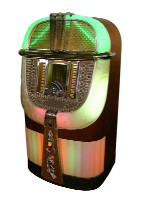10 Things I Didn’t Know About Jukeboxes
Fun Trivia I had lunch a few weeks ago in a 50s’ style diner and on the table was a miniature jukebox. My son and I started chatting about what he referred to as the “old days” and asked me what I remembered about jukeboxes. Well, seeing that they were around a long time before I came along¦ that wasn’t very much. But it did make me curious.
I had lunch a few weeks ago in a 50s’ style diner and on the table was a miniature jukebox. My son and I started chatting about what he referred to as the “old days” and asked me what I remembered about jukeboxes. Well, seeing that they were around a long time before I came along¦ that wasn’t very much. But it did make me curious.
1. Just in case you ever wondered, the term “juke” is a southern term for dancing. Makes sense when you think about it. The dances might have been a little different back in those days, but the kids still loved it.
2. The manufacturers of the Jukeboxes never referred to them as “jukeboxes” they referred to them as Automatic Coin-Operated Phonographs. You know where their minds were at the time.
3. Everyone else referred to them as Nickel-in-a-Slot machines for obvious reasons. Early models could play 45rpm or 78rpms, but just one side at a time. That would change as soon as technology figured out a way to flip the record.
4. Jukeboxes began holding between 12 and 16 records at the most and patrons were not able to pick and choose their songs. The records were simply played in order. And the early models did not resemble the jukeboxes that we have become accustomed to at all. They were made of wood and had flat tops.
5. It wasn’t until the late 30s’ that mechanisms were added that would allow the choice of records to be played. But, things weren’t quite what they seemed. See #8!
6. Tavern owners loved the ideas of jukeboxes as the economic depression of the late thirties made hiring a band almost impossible. Being able to feature music, even out of a box, brought kids and money into their establishment in droves.
7. Much to the delight of kids, jukeboxes soon began appearing in drugstores, ice cream parlors and small dancehalls.
8. It was during the 1950s’ that miniature juke were placed on all the tables in diners. Patrons could pick and choose what song they ate lunch to! At least, that’s what they thought. What they didn’t know is that songs were played in sequence of songs actually paid for. The same song could have been chosen by several tables, and no one knew the difference. The top hits made the restaurant style diners a lot of money.
9. Rock Around the Clock was just that¦ a number one hit in 1955. I wonder how many nickels that song made!
10. No one is really sure just how many jukeboxes were actually made, but it is thought to be around 2 million. Would love to get my hands on one of the early ones. I have lots of nickels! It would be like stepping back in time.
